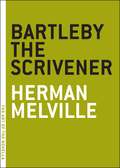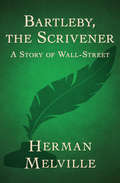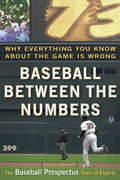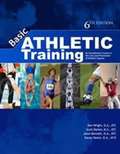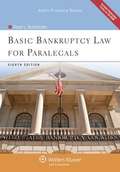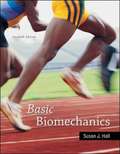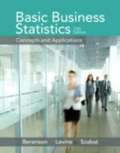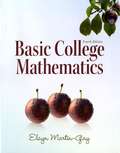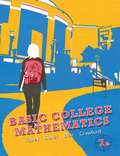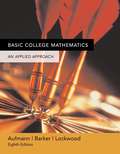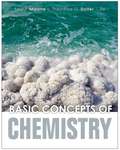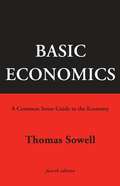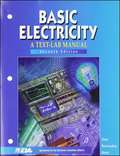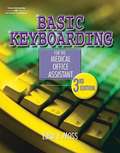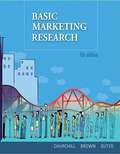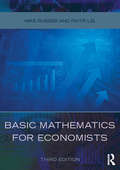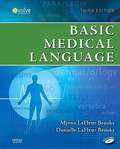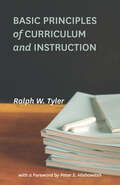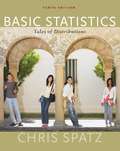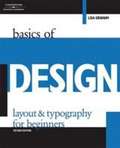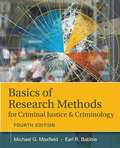- Table View
- List View
Bartleby the Scrivener: Large Print (The Art of the Novella)
by Herman Melville"I prefer not to," he respectfully and slowly said, and mildly disappeared. Academics hail it as the beginning of modernism, but to readers around the world--even those daunted by Moby-Dick--Bartleby the Scrivener is simply one of the most absorbing and moving novellas ever. Set in the mid-19th century on New York City's Wall Street, it was also, perhaps, Herman Melville's most prescient story: what if a young man caught up in the rat race of commerce finally just said, "I would prefer not to"? The tale is one of the final works of fiction published by Melville before, slipping into despair over the continuing critical dismissal of his work after Moby-Dick, he abandoned publishing fiction. The work is presented here exactly as it was originally published in Putnam's magazine--to, sadly, critical disdain. Too short to be a novel, too long to be a short story, the novella is generally unrecognized by academics and publishers. Nonetheless, it is a form beloved and practiced by literature's greatest writers. In the Art Of The Novella series, Melville House celebrates this renegade art form and its practitioners with titles that are, in many instances, presented in book form for the first time.
Bartleby, the Scrivener: A Story of Wall-Street (Coleccion Cara Y Cruz)
by Herman MelvilleThe classic tale of existential despair A Wall Street lawyer specializing in bonds and mortgages hires a respectable young man to copy legal documents by hand. At first, the new scrivener approaches his duties with a calm efficiency. Then comes the day when his response to a new assignment is, &“I would prefer not to.&” The mysterious phrase soon becomes Bartleby&’s reply to everything asked of him, and his surrender to inertia is both maddening and inexorable. Torn between frustration and pity, anger and sorrow, his employer desperately tries to save Bartleby, but the cause is as doomed to disappointment as life itself. A strange and haunting fable that continues to resonate a century and a half after it was first published, Bartleby, the Scrivener is a masterpiece of American literature. This ebook has been professionally proofread to ensure accuracy and readability on all devices.
Baseball Between the Numbers: Why Everything You Know About the Game Is Wrong
by Jonah Keri Baseball ProspectusIn the numbers-obsessed sport of baseball, statistics don't merely record what players, managers, and owners have done. Properly understood, they can tell us how the teams we root for could employ better strategies, put more effective players on the field, and win more games. The revolution in baseball statistics that began in the 1970s is a controversial subject that professionals and fans alike argue over without end. Despite this fundamental change in the way we watch and understand the sport, no one has written the book that reveals, across every area of strategy and management, how the best practitioners of statistical analysis in baseball-people like Bill James, Billy Beane, and Theo Epstein-think about numbers and the game. Baseball Between the Numbers is that book. In separate chapters covering every aspect of the game, from hitting, pitching, and fielding to roster construction and the scouting and drafting of players, the experts at Baseball Prospectus examine the subtle, hidden aspects of the game, bring them out into the open, and show us how our favorite teams could win more games. This is a book that every fan, every follower of sports radio, every fantasy player, every coach, and every player, at every level, can learn from and enjoy.
Basic Athletic Training: An Introductory Course in the Care and Prevention of Injuries (Sixth Edition)
by Ken Wright Scott Barker William R. Whitehill Jason BennettThis is a comprehensive introduction to current philosophies, procedures, and practices related to the care and prevention of athletic injuries. It is written and edited by Board of Certification (BOC) certified athletic trainers as a comprehensive introduction to current philosophies, procedures, and practices related to the care and prevention of athletic injuries.
Basic Bankruptcy Law for Paralegals (8th Edition)
by David L. BuchbinderBasic Bankruptcy Law for Paralegals focuses on what paralegals need to know to be effective paralegals in a bankruptcy practice. Comprehensive yet accessible, this proven-effective text offers a step-by-step overview of the bankruptcy code and rules. With a consistent emphasis on practice, David Buchbinder vividly describes the role of the paralegal at every stage of a bankruptcy proceeding, providing practical information along the way. A wealth of examples, checklists, and summaries put bankruptcy law squarely within reach. This text is available in ebook format from the Vital Source Store . To download and use the ebook, you will need the free Vital Source Bookshelf software. DOWNLOAD NOW Thoroughly updated, the Eighth Edition includes new Supreme Court cases that interpret bankruptcy law and recent changes to the Federal Rules of Bankruptcy Procedure. a favorite among paralegal instructors, Basic Bankruptcy Law for Paralegals features:a clear and readable writing style designed to let students learn and digest the basics complete coverage of everything a student needs to know to become a competent bankruptcy paralegal --consumer representation, creditor representation, and assisting with a Chapter 11 case a useful overview of the bankruptcy code and rules that sheds light on the role of the paralegal at every stage of a bankruptcy proceeding practical information about how and when to complete bankruptcy documents a rich variety of learning and memory aids, such as examples,checklists of procedures, summaries of the law, and discussion questions a Forms Manual on CD-ROM a generous teaching package, including a detailed Instructor's Manual, Test Bank, PowerPoints, and Best Case Exercises Updated throughout, the Eighth Edition of Basic Bankruptcy Law for Paralegals includes: recent case rulings interpreting bankruptcy law developments and changes in the Federal Rules of Bankruptcy Procedure *Instructor's Manuals are a professional courtesy offered to professors only. For more information or to request a copy, please contact Wolter's Kluwer Law & Business at 800.529.7545 or examcopy@wolterskluwer.com.
Basic Biomechanics (Seventh Edition)
by Susan J. HallThe seventh edition of Basic Biomechanics has been significantly updated from the previous edition. The approach taken remains an integrated balance of qualitative and quantitative examples, applications, and problems designed to illustrate the principles discussed. The seventh edition also retains the important sensitivity to the fact that some beginning students of biomechanics possess weak backgrounds in mathematics. For this reason, it includes numerous sample problems and applications, along with practical advice on approaching quantitative problems. With balanced, integrated coverage of applied anatomy, mechanical principles, and relevant sport and daily living applications, this text introduces you to the basics of biomechanics. The quantitative aspects of biomechanics are presented in a manageable, progressive fashion, with practical advice on approaching both qualitative and quantitative problems in biomechanics.
Basic Business Statistics: Concepts and Applications
by Mark L. Berenson David M. Levine Kathryn A. SzabatStatistics is essential for all business majors and this text helps students see the role statistics will play in their own careers by providing examples drawn from all functional areas of business. Guided by principles set by major statistical and business science associations (ASA and DSI), plus the authors' diverse teaching experiences, the Thirteenth Edition of Berenson/Levine/Szabat's Basic Business Statistics continues to innovate and improve the way this course is taught to all students.
Basic College Mathematics
by Elayn Martin-GayElayn Martin-Gay firmly believes that every student can succeed, and her developmental math textbooks and video resources are motivated by this belief. Basic College Mathematics, Fourth Edition was written to help readers effectively make the transition from arithmetic to algebra. The new edition offers new resources like the Student Organizer and now includes Student Resources in the back of the book to help students on their quest for success.
Basic College Mathematics
by Jeffrey Slater Jamie Blair Jennifer Crawford John TobeyThe Tobey/Slater/Blair/Crawford series builds essential skills one at a time by breaking the mathematics down into manageable pieces. This practical "building block" organization makes it easy for students to understand each topic and gain confidence as they move through each section. Students will find many opportunities to check and reinforce their understanding of concepts throughout the text. With this revision, the author team has added a new Math Coach feature that provides students with an office hour experience by helping them to avoid commonly made mistakes. With Tobey/Slater/Blair/Crawford, students have a tutor, a study companion, and now a coach, with them every step of the way.
Basic College Mathematics: An Applied Approach (Eighth Edition)
by Richard N. Aufmann Vernon C. Barker Joanne S. LockwoodWith its complete, interactive, objective-based approach, Basic College Mathematics is the best-seller in this market. The Eighth Edition provides mathematically sound and comprehensive coverage of the topics considered essential in a basic college math course. Furthermore, the Instructor's Annotated Edition features a comprehensive selection of instructor support material. The Aufmann Interactive Method is incorporated throughout the text, ensuring that students interact with and master the concepts as they are presented. This approach is especially important in the context of rapidly growing distance-learning and self-paced laboratory situations.
Basic Concepts of Chemistry (Ninth Edition)
by Leo J. Malone Theodore DolterThe 9th edition of Malone's Basic Concepts of Chemistry provides many new and advanced features that continue to address general chemistry topics with an emphasis on outcomes assessment. New and advanced features include an objectives grid at the end of each chapter which ties the objectives to examples within the sections, assessment exercises at the end each section, and relevant chapter problems at the end of each chapter. Within WileyPLUS, content is organized into "concept modules" that contain clear learning objectives from the text; examples, to help "show" how to do things; and automatically graded practice problems embedded in the content, to test knowledge. A new Math Check allows quick access to the needed basic skill. The first chapter now includes brief introductions to several fundamental chemical concepts and Chapter Synthesis Problems have been added to the end of each chapter to bring key concepts into one encompassing problem. Every concept in the text is clearly illustrated with one or more step by step examples. Making it Real essays have been updated to present timely and engaging real-world applications, emphasizing the relevance of the material they are learning. This edition continues the end of chapter Student Workshop activities to cater to the many different learning styles and to engage users in the practical aspect of the material discussed in the chapter.
Basic Economics 4th Ed
by Thomas SowellWhy are homeless people sleeping on the sidewalks of New York in the winter, when the abandoned apartment buildings in the city have four times as many dwelling units as there are homeless people in the city? Why did Russians have to import food to feed people in Moscow, when Russia itself had vast amounts of some of the richest farmland in Europe within easy driving distance? Why did unemployment reach 25 percent and American corporations as a whole operate in the red for two years in a row during the Great Depression of the 1930s? All these very different, but equally puzzling and needless, tragedies grew out of a failure to understand and apply basic economics principles. Explaining these principles for the general public in plain English, with neither graphs nor equations nor jargon, is the goal and achievement of Basic Economics by Thomas Sowell. His lively examples are drawn from around the world and from centuries of history because the basic principles of economics are not limited to modern capitalist societies and apply even to situations where no money changes hands, such as caring for wounded soldiers on a battlefield. The focus of Basic Economics is not on how individuals make money but on how societies create prosperity or poverty for their peoples by the way they organize their economies. Prosperous countries with few natural resources, such as Japan and Switzerland, are as common as poor countries with rich resources, such as Russia and Mexico. The fourth edition of Basic Economics is both expanded and updated. A new chapter on the history of economics itself has been added, and the implications of that history examined. A new section on the special role of corporations in the economy has been added to the chapter on government and big business, among other additions throughout the book. Basic Economics, which has now been translated into six languages, has grown so much that a large of amount of material in the back of the book in previous editions has now been put online instead. The central idea of Basic Economics, however, remains the same: that the fundamental facts and principles of economics do not require jargon, graphs, or equations, and can be learned in a relaxed and even enjoyable way.
Basic Economics 4th Ed
by Thomas SowellA revised edition of the classic introduction to economics, updated with new material on the economic crisis of 2008 and the first years of the Obama administrationOCOs policies. "
Basic Economics 4th Ed
by Thomas SowellWhy are homeless people sleeping on the sidewalks of New York in the winter, when the abandoned apartment buildings in the city have four times as many dwelling units as there are homeless people in the city? Why did Russians have to import food to feed people in Moscow, when Russia itself had vast amounts of some of the richest farmland in Europe within easy driving distance? Why did unemployment reach 25 percent and American corporations as a whole operate in the red for two years in a row during the Great Depression of the 1930s? All these very different, but equally puzzling and needless, tragedies grew out of a failure to understand and apply basic economics principles. Explaining these principles for the general public in plain English, with neither graphs nor equations nor jargon, is the goal and achievement ofBasic Economicsby Thomas Sowell. His lively examples are drawn from around the world and from centuries of history because the basic principles of economics are not limited to modern capitalist societies and apply even to situations where no money changes hands, such as caring for wounded soldiers on a battlefield. The focus ofBasic Economicsis not on how individuals make money but on how societies create prosperity or poverty for their peoples by the way they organize their economies. Prosperous countries with few natural resources, such as Japan and Switzerland, are as common as poor countries with rich resources, such as Russia and Mexico. The fourth edition ofBasic Economicsis both expanded and updated. A new chapter on the history of economics itself has been added, and the implications of that history examined. A new section on the special role of corporations in the economy has been added to the chapter on government and big business, among other additions throughout the book. Basic Economics, which has now been translated into six languages, has grown so much that a large of amount of material in the back of the book in previous editions has now been put online instead. The central idea ofBasic Economics, however, remains the same: that the fundamental facts and principles of economics do not require jargon, graphs, or equations, and can be learned in a relaxed and even enjoyable way.
Basic Electricity: A Text-Lab Manual (Seventh Edition)
by Paul B. Zbar Gordon Rockmaker David J. BatesDesigned for use in traditional DC/AC courses, this text serves equally well as a stand-alone introductory text and lab manual or as a lab manual for use with any basic theory text. The content of this text/lab manual is prepared with the technical assistance of the Electronic Industries Association, guaranteeing that the material is consistent with the competencies of the electronics manufacturing and service industries.
Basic Keyboarding for the Medical Office Assistant (3rd Edition)
by Edna Jean MossThis is a basic keyboarding book for medical assistants, medical secretaries and transcriptionists that include medical terminology case histories, technical information, and medical timed writings that is needed for any medical facility and all personnel
Basic Marketing Research 7th Edition
by Gilbert A. Churchill Tom J. Brown Tracy A. SuterThis book provides an introductory look at marketing research for undergraduate students, managerially oriented graduate students, or anyone who wants an appreciation of the marketing research process.
Basic Math Review for Statistics Students
by Zealure C. HolcombProvides a fresh start for students to learn the essentials underlying achievement in the computational aspects of statistics.
Basic Mathematics for Economists
by Piotr Lis Mike RosserBasic Mathematics for Economists, now in its 3rd edition, is a classic of its genre and this new edition builds on the success of previous editions. Suitable for students who may only have a basic mathematics background, as well as students who may have followed more advanced mathematics courses but who still want a clear explanation of fundamental concepts, this book covers all the basic tenets required for an understanding of mathematics and how it is applied in economics, finance and business. Starting with revisions of the essentials of arithmetic and algebra, students are then taken through to more advanced topics in calculus, comparative statics, dynamic analysis, and matrix algebra, with all topics explained in the context of relevant applications, New features in this third edition reflect the increased emphasis on finance in many economics and related degree courses, with fuller analysis of topics such as: savings and pension schemes, including draw down pensions asset valuation techniques for bond and share prices the application of integration to concepts in economics and finance input-output analysis, using spreadsheets to do matrix algebra calculations In developing new topics the book never loses sight of their applied context and examples are always used to help explain analysis. This book is the most logical, user-friendly book on the market and is usable for mathematics of economics, finance and business courses in all countries.
Basic Medical Language (Third Edition)
by Myrna Lafleur Brooks Danielle Lafleur BrooksFocused on the basic word analysis skills you need for medical terminology, Basic Medical Language, 3rd Edition includes a carefully selected group of suffixes, prefixes, and word roots to give you a foundation for recognizing and communicating medical terms. A combination of body system lessons, anatomy presentations, and introductions to word parts reinforce basic word building skills. Plus, you can take charge of your learning with the companion CD packaged with the text and an online audio program for additional practice. Beginning with word parts and moving on to whole words, the systematic presentation equips you to recognize and define new words as you encounter them. A variety of learning exercises tests your knowledge and provides instant feedback on your progress. The Abbreviations tables include the most common medical abbreviations you'll encounter in the healthcare setting. Review sections within each lesson reinforce your learning. Consistent organization and pacing of lessons steadily build your knowledge and vocabulary. Coverage of every body system ensures you have all the basic medical terminology content you need. FYI boxes include practical and interesting information to spark your curiosity. Over 200 flash cards printed on card stock and bound with the book provide a portable way to study. At-a-Glance sections provide a quick review to help you get the most out of each lesson. New illustrations and diagnostic images show the latest developments in the clinical environment. Exercises like Interact with Medical Documents and others help you understand and use terms with the documents you'll use in practice. Outline/Objectives highlight the most important information for each chapter. Icons throughout the text direct you to the companion CD to enhance your learning experience. Two new games, updated activities, and animations on the companion CD reinforce your learning and provide additional background for pathologies and procedures in the text. The online audio program ensures proper pronunciation of terms.
Basic Principles of Curriculum and Instruction
by Ralph W. TylerThe acclaimed classic shows educators how to set classroom objectives, select learning experiences, organize instruction, and evaluate progress.In 1949, a small book had a big impact on education. In just over one hundred pages, Ralph W. Tyler presented the concept that curriculum should be dynamic, a program under constant evaluation and revision. Curriculum had always been thought of as a static, set program, and in an era preoccupied with student testing, he offered the innovative idea that teachers and administrators should spend as much time evaluating their plans as they do assessing their students.Since then, Basic Principles of Curriculum and Instruction has been a standard reference for anyone working with curriculum development. Although not a strict how-to guide, the book shows how educators can critically approach curriculum planning, studying progress and retooling when needed. Its four sections focus on setting objectives, selecting learning experiences, organizing instruction, and evaluating progress. Readers will come away with a firm understanding of how to formulate educational objectives and how to analyze and adjust their plans so that students meet the objectives. Tyler also explains that curriculum planning is a continuous, cyclical process, an instrument of education that needs to be fine-tuned.This emphasis on thoughtful evaluation has kept Basic Principles of Curriculum and Instruction a relevant, trusted companion for over sixty years. And with school districts across the nation working feverishly to align their curriculum with Common Core standards, Tyler’s straightforward recommendations are sound and effective tools for educators working to create a curriculum that integrates national objectives with their students’ needs.Praise for Basic Principles of Curriculum and Instruction“Tyler addresses the essential purposes of teaching in a way that still has relevance for contemporary students of education, and communicates to them how important and timeless the quality of the pupil-teacher interaction actually is.” —Times Higher Education (UK)
Basic Statistics: Tales Of Distributions
by Chris SpatzLearn statistical reasoning and problem solving from a best-selling author who uses a wealth of examples from the social and behavioral sciences,, education,, nursing/allied health, and business fields--as well as examples from everyday life-to help you learn and understand. Praised for his clear explanations, Spatz shows you how to start with a data set, identify the questions it poses, determine and carry out statistical procedures, and using plain English, tell the story the data reveal.
Basics of Design: Layout and Typography for Beginners (2nd edition)
by Lisa GrahamThis classic introduction to high-impact page design is now fully updated for a new generation of designers. Basics of Design: Layout and Typography for Beginners demystifies the design process with straightforward and complete explanations of the fundamental principles that create first-rate visual design. Readers learn essential design terminology and develop their knowledge and skills through visual examples and hands-on activities that reinforce page layout and typography concepts. Side-by-side critiques of before-and-after page layouts help readers understand how to apply design principles to their own efforts and point the way to excellence in design.
Basics of Research Methods for Criminal Justice and Criminology
by Earl R. Babbie Michael G. MaxfieldThe text introduces you to the basics of criminal justice research utilizing real data and featuring coverage of such key issues as ethics, causation, validity, field research, and research design.
Basics of Research Methods for Criminal Justice and Criminology
by Earl R. Babbie Michael G. MaxfieldA concise paperback based on Maxfield and Babbie's best-selling RESEARCH METHODS FOR CRIMINAL JUSTICE AND CRIMINOLOGY, this "basics" version combines accessibility and a conversational writing style with Michael G. Maxfield's expertise in criminology and criminal justice. In fewer than 400 pages, BASICS OF RESEARCH METHODS FOR CRIMINAL JUSTICE AND CRIMINOLOGY, Fourth Edition, introduces students to the core of criminal justice research. It utilizes the most current, real data and features coverage of such key topics as ethics, causation, validity, field research, and research design, among others. The Fourth Edition includes expanded coverage of qualitative research and interviewing, focus groups in criminological research, and snowball sampling, as well as additional examples of student research. Balancing coverage of both qualitative and quantitative methods, the text is packed with real-world examples, practical applications, and Internet research exercises.
